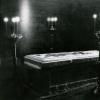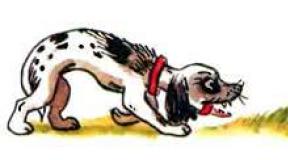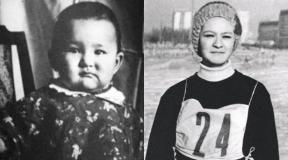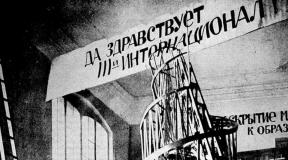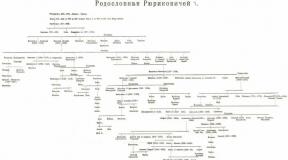X-ray examination methods in dentistry. Radiation research methods used in dentistry. Radiography using contrast agents
X-RAY EXAMINATION
In modern dentistry, various X-ray diagnostic methods are widely used. The main method of X-ray examination in surgical dentistry is radiography. IN Lately New methods of X-ray examination of teeth and jaws have been developed and put into practice - panoramic tomography, teleradiography, X-ray cinematography, which make it possible to give a more complete X-ray characterization of most dental diseases.
There are two methods of dental radiography - intraoral (intraoral) and extraoral (extraoral). Intraoral photographs, in turn, are divided into contact and bite-based.
When taking contact photographs, a film wrapped in black or wax paper is pressed against the mucous membrane of the inner surface of the alveolar process of the jaw. Bite photographs - the film is clamped between the teeth of the upper and lower jaws. Extraoral x-rays are often used to view the mandible, facial bones, temporomandibular joint, paranasal sinuses, zygomatic and cranial bones, and salivary glands.
On survey radiographs of the facial bones in direct, lateral and axial projections, both (upper and lower) jaws and palatine bones, forming the bony walls of the oral cavity, are identified. For a detailed analysis of a number of anatomical formations, special targeted images are used. Sight radiography is performed intra- and extraorally. Intraoral photographs taken in the bite are used to study the bony palate, alveolar processes of the upper and lower jaws, and the floor of the mouth. Contact intraoral photographs with a film pressed against the alveolar process make it possible to study the structure of the corresponding limited areas of the upper and lower jaws, periodontium and teeth. Extraoral x-rays are taken to study the structure of the bones of the maxillofacial area.
The upper jaw in a direct anterior projection can be traced from the infraorbital margin to the alveolar process. It is projectively shortened. In the lateral sections, the body of the upper jaw is limited by a clear concave contour, smoothly passing outward and upward into the zygomatic bone. The nasal cavity is located medially above the bony palate, and the sinuses of the same name are located laterally in the bodies of the maxillary bones. In the nasomental projection, the distortion of the body of the upper jaw is less than in the anterior view. In the lateral projection, the right and left upper jaws are projectively summed up. The bony palate is represented by an intense linear shadow extending to the anterior part of the alveolar process of the upper jaw. At this level it bifurcates. One of the lines, continuing horizontally anteriorly, is the bottom of the nasal cavity, and the second, arcuately deviating downwards, is formed by the vault of the oral cavity. The alveoli and teeth are not clearly differentiated due to summation.
Intraoral radiography of the bony palate is performed in the axial chin position. The central x-ray beam is directed from top to bottom at the tip of the nose in relation to the film at an angle of 75°, open anteriorly. The bony palate on intraoral radiographs is defined as irregular rectangles with an anterior rounded contour. The posterior contour cannot be reproduced, since it is impossible to introduce the film into the oral cavity to the required depth. The anterior and lateral contours of the bony palate are bordered by the alveolar arch with teeth located on it. The structure of the bony palate is finely looped, oval or round shape with alveolar lacunae measuring 3-5 mm, located near the incisors in the thickness of the spongy substance.
The median palatine suture can be traced in the sagittal plane. The incisive foramen has the appearance of an oval lucency, turning into a narrow slit-like incisive canal, located parallel or at an angle to the median palatal suture. When the projection coincidence of the incisive foramen with the apex of the incisor root, it resembles a granuloma. Unlike granuloma, the incisive opening, projected onto the root of the tooth, and on repeated radiographs taken with a change in the centering of the beam of rays, projectionally moves relative to its root. In this case, the tooth and periodontal gap are not changed.
The lower jaw is also examined on survey and targeted radiographs. On survey x-rays of the facial bones in the anterior and nasomental projections, the body of the jaw is projected in the form of an irregular quadrangle with a convex lower contour, passing into the area of the angle in its branches. The base of the lower jaw is represented by a clear wide (up to 2-4 mm) strip of the cortical layer. The formation of the upper contour is due to the alveolar arch of the lower jaw and the alveoli with the teeth located in them. On a radiograph in the nasomental projection, the sockets and heads of the temporomandibular joints with the articular spaces located between them, as well as the neck of the lower jaw, are clearly visible, which makes it possible to evaluate them in comparison. The coronoid and condylar processes coincide in projection.
On a radiograph taken in an axial projection, the lower jaw is projected onto the middle cranial fossa and gives a convex horseshoe-shaped shadow caused by the body and projectionally shortened branches of the lower jaw. The condylar processes end in transversely oriented ovals of the head of the mandible. The coronoid processes are revealed in the form of triangular pointed formations located medially from the condylar ones. On a targeted lateral radiograph of the lower jaw, the same details are determined as on a survey one, but without significant projection layering. The examined half of the body of the lower jaw and its branch with the coronoid and condylar processes and the notch located between them are clearly visible. The anterior section of the jaw body, oriented orthogradely along the central ray, forms an oval-shaped clearing with clear, intense contours. The cortical layer of the base of the lower jaw reaches 3-4 mm in an adult.
The alveolar arch of the lower jaw does not have projection layers to the level of the premolars; it is covered medially by the opposite side of its body. The structure of the spongy substance is broadly looped. In the body and lower part of the jaw branch, the mandibular canal can be traced - a linear clearing with dense walls. At the point of transition of the body into the branch there is an arched or obtuse angle of the lower jaw. The coronoid process is clearly contoured, its apex can projectively coincide with the angle of the opposite side of the lower jaw, less often with the tubercle of the upper jaw. The condylar process coincides with the image of the cervical vertebrae.
On a targeted radiograph of the temporomandibular joint, taken in a lateral projection, the bottom of the glenoid cavity is clearly defined. Anterior to it is the articular tubercle of the temporal bone, which continues at the base of the zygomatic arch. The head of the lower jaw has the shape of a compacted semi-oval and smoothly passes into the condylar process of the jaw. The head is covered with a thin cortical layer, which thickens significantly in the neck area. The joint space is widened in the central section, corresponding to the deepening of the bottom of the articular cavity.
Application of the X-ray method of research in the diagnosis of odontogenic inflammatory diseases. Periodontitis is inflammation of periodontal tissue. Granulating periodontitis is an active form of inflammation, characterized by frequent exacerbations. With granulating periodontitis, on radiographs performed using the intraoral method of examination (regardless of the degree of exacerbation), in the bone at the apex of the tooth root one can discern an area of bone tissue resorption with uneven and unclear contours. Bone destruction can spread to the alveoli of adjacent teeth. Sometimes partial resorption of the root of the causative tooth is detected. Periodontitis of multi-rooted teeth leads to resorption of the interradicular bone septum. At the same time, on radiographs, the roots of the teeth are visible against the background of an area of osteolysis of bone tissue that does not have clear boundaries. Chronic periodontitis of the central incisors of the lower jaw, especially traumatic, is accompanied by bone loss around their roots and resembles a perihilar cyst in size and shape. The final diagnosis is established after pathohistological examination of the removed tissues.
Granulomatous periodontitis (granuloma) is asymptomatic for a long time. On x-rays taken using the intraoral method of examination, a center of destruction of a round shape with clear contours is detected at the apex of the tooth root. The apices of the roots of the teeth included in the granuloma are often resorbed. In children, during the formation of the apex of the roots of the teeth, on radiographs these places resemble a granuloma, especially if a carious cavity is found in the coronal part of the tooth. It should be remembered that with granulomas the end plate of the alveoli is partially destroyed, but in growing teeth at the stage of an unclosed apex it is preserved. At the stage of the Unformed apex, the root is thin, with a wide canal, expanding in the form of a center of clearing, clearly surrounded by a closing plate.
Fibrous periodontitis is essentially the outcome of an acute inflammatory process. On the radiograph, the periodontal fissure of the affected tooth is widened over a large area and narrows in places. If the periodontium has undergone ossification as a result of inflammation, the periodontal fissure is absent on the radiograph.
Periostitis. Exacerbation of chronic periodontitis leads to acute periostitis of the jaws. According to radiological signs, acute periostitis is indistinguishable from periodontitis, while chronic periostitis is characterized by radiological changes. A muff-like compaction with smooth and indistinct boundaries appears on the lower jaw. Bite radiographs reveal a soft tissue shadow of infiltrated periosteum. Chronic ossifying periostitis is detected on the outer surface of the lower jaw in the form of a linear shadow or hemispherical bone formation, inferior in intensity to the structure of the cortical substance of the jaw. Referential periostitis most often has a post-traumatic origin and is localized in the lower jaw in the area of the anterior teeth. X-ray shows a focus of osteoporosis of bone tissue with fairly clear boundaries, which resembles a radicular cyst, but unlike it, the periodontal gap of the teeth located in the affected area is not changed.
Odontogenic osteomyelitis. It is impossible to differentiate acute odontogenic osteomyelitis of the jaw from periostitis radiographically, since the phenomena of destruction are not yet clearly expressed. Bone necrosis occurs on the 3rd-4th day, but the first signs of bone tissue damage on radiographs can be detected only by the end of the 2-3rd week from the onset of the disease. Changes in the jaw are manifested by the unclearness of their structure, and subsequently foci of osteolysis or necrosis appear. In the subacute phase, a zone of sclerotic demarcation gradually appears around them, more clearly expressed in the lower jaw. In the upper jaw after 5-6 weeks, and in the lower jaw after 6-7 weeks, cavities containing bone sequestra, denser than the surrounding bone tissue, are clearly visible on X-ray. The edges of the sequestra are uneven, jagged. Between them and the viable bone tissue, a clearing zone is visible; its appearance is due to the formation of pus and granulations. In the chronic phase, as sclerosis develops, sequestral cavities form. Around them in the lower jaw, as a result of subperiosteal bone formation, a sequestral capsule is formed, clearly visible on the radiograph. A sequestral capsule does not form on the upper jaw. Bone regeneration in the upper jaw is much less pronounced than in the lower jaw. Chronic odontogenic osteomyelitis after removal of rejected bone sequestra is completed by reparative processes. After sequestrectomy, X-ray control is performed. Its implementation is necessary to determine the effectiveness of surgical treatment and detect bone regeneration.
Pericoronitis. An X-ray of the lower jaw taken in a lateral view shows the wisdom tooth in an incorrect position in relation to the lower jaw and other teeth. It can be tilted (at different angles) with the crown forward or backward. In the first case, it rests on the tooth in front, in the second - on the anterior edge of the lower jaw branch. In a strictly vertical position, the tooth is in inclusion. With repeated exacerbations, an x-ray taken in a lateral projection can reveal bone resorption between the second and third molars or behind the crown of the wisdom tooth, in the anterior edge of the mandibular ramus. The presence of these changes and corresponding clinical symptoms allows us to establish a diagnosis with maximum confidence. The tactics of medical manipulations depend on the nature of the changes detected radiographically in the hard tissues of the tooth in front and in the bone tissue surrounding the crown of the wisdom tooth on the distal side. According to Harniseh, expansion of up to 2 mm of the pericoronal space on the distal side of the wisdom tooth crown is a physiological norm.
Odontogenic sinusitis. To study diseases of the maxillary sinus and identify their causal relationship with the teeth of the upper jaw, both intraoral and extraoral x-rays. In our opinion, of all the positions used for radiography of the maxillary sinuses, the most appropriate is the anterior nasofrontal one. Inflammatory processes in the maxillary sinus they create an x-ray picture from slight veiling to complete disappearance of radiation permeability. If during a tooth extraction operation the root is pushed into the maxillary sinus, it is not always possible to detect it on extraoral x-rays. To locate the tooth, an intraoral contact photograph is taken.
Contrast radiography of the salivary glands - sialography - is a reliable diagnostic method and is included in the examination plan for patients with inflammatory diseases of the corresponding anatomical areas.
For sialography, we use aqueous solutions of triiodinated organic compounds: Visotrast 76%, Urotrast 75%, Verotrast 76%, Urografin 76%, etc. They are low-toxic, quite radiopaque, have a high resorption capacity, due to which they do not remain in the gland even with significant impairment its functions. However, it is difficult to administer water-soluble radiopaque contrast agents with a conventional syringe. A. M. Solntsev and co-authors developed a special technique for sialography using water-soluble X-ray contrast agents.
Although new methods of radiation diagnostics are now being developed, radiography still remains the primary choice in identifying diseases of the jaw and oral cavity. It is very popular in identifying dental diseases.

Dental radiography methods
Here are examples of pathologies where x-rays are needed to diagnose the condition of the patient’s teeth, gums, and entire jaw:
- injuries;
- inflammation;
- cysts;
- tumors.

Radiography has some character traits. Here are the most popular dental radiography techniques:
- intraoral;
- extraoral;
- overview;
- telephoto

Intraoral
Intraoral x-rays are used using a dental apparatus. Now equipment is being produced for this purpose, which can be used to take both classic photographs using special film and digital ones.
Interesting! A portable version of this equipment can be purchased for 70,000-100,000 rubles.

The patient must be completely still during dental x-rays, otherwise the image will be unclear. In order not to move, the patient sits in a special comfortable chair.

Intraoral radiography is the main tool for identifying most dental diseases. Here modern methods intraoral radiography that are used today:
- intraoral contact;
- occlusal (intraoral bite);
- interproximal;
- telephoto

For many years, the main way to detect dental diseases was contact x-rays, performed according to the bisector rule or isometric projection. This technique was created by the Polish dentist Cieszynski back in 1907. The main expectation of this technique is to obtain a clear image of the periapical tissues. To do this, the beam is centered at a point that is a projection of the apex of the root of the molar being examined. Another goal of the method is to obtain life-size images of molars. To keep distortion to a minimum, the isometric rule is applied. Simply put, the beam goes to the top of the tooth root, and always at a right angle to the bisector of the angle formed by the axis of the tooth and the plane of the film.
Important! If the beam goes any other way, the displayed tooth length will certainly be distorted.

The image taken in this way should not be shorter than the actual dimensions of the tooth, and its length should not exceed the natural one by more than one tenth. On the other hand, it is impossible to follow the rules of isometry exactly. This is because it is very difficult to clearly identify in each patient the bisector of the angle created by the dental axis and the plane of the film. Therefore, they use the angle of inclination of the tube, calculated by observation and comparison for each dental group.
Here are the angles at which the X-ray tube should be tilted to the horizontal plane for each group:
- - 25-30 degrees;
- - 35;
- fangs - 45;
- incisors - 55.

If you shoot a bite, the angle of inclination should be 20 degrees greater. It is important to follow the orthoradiality rule here. That is, the beam at the moment of the picture goes at a right angle to the tangent that was drawn to the dental arch in the area of the tooth being examined. Then his image is not distorted by overlapping images of molars in the neighborhood.
Interesting! For contact photography, a 2x3 or, alternatively, 3x4 cm film is used. And for bite-shot photography, a 5x6 or 6x8 cm film is used.

In order to prevent injuries to the mucous membrane, the corners of the film must first be cut off. After that, it is placed in two small envelopes: first in one made of special paper that does not allow light to pass through, and this in a waxed envelope. The bag thus obtained is placed in the mouth, and the patient must press it against the hard palate, as well as against the alveolar process of the area being examined.
Important! For dental x-rays, the patient must be in a chair. His head must be fixed on the headrest exactly as required for the procedure.
If the upper jaw is being examined, it is important that the head is in a position where the wings of the nose and the external auditory canal are vertical. The doctor inserts the film exactly so that the edge does not intersect with the occlusal plane and protrudes from behind the teeth by half a centimeter.

If the lower jaw is examined, the patient’s head must be fixed so that the line that connects the angle of the open mouth and the tragus of the ear is strictly vertical. He needs to lift his head a little.
Sometimes it is necessary to specially adjust the beam so that separate images of the roots of multi-rooted teeth are received, or to determine how the roots interact with neoplasms. Then oblique intraoral projections are already used.

Important! This method has a significant disadvantage - the inability to find out in what condition the marginal sections of the interalveolar ridges are. This is because it shoots with a slanted beam, making the image shorter. So this is useless for diagnosing the pathology of the gums and other tissues surrounding and fixing the tooth.
Interproximal
This method is used when it is necessary to obtain a high-quality image of the marginal parts of the jaw processes. In this way, bone resorption can be determined without embellishment over time. This method also represents the best opportunity to detect the carious process - approximal and.

The doctor here uses special film holders to place the film in the patient’s mouth so that it does not intersect with the dental crowns, but is at a certain distance from them. This way you can get a picture of symmetrical places on both jaws. The film is fixed with a piece of thick paper: it is attached to its wrapper and clamped between closed teeth. The beam goes at right angles to the film and the tops of the teeth.
Important! In the photographs you can immediately see the crowns of the teeth and the marginal sections of the alveolar sections of both jaws.

Interesting! To study all the teeth at once, three to four images are required.
Occlusal
This method is popular and simple. They resort to it in the following cases:
- it is necessary to examine large areas of the alveolar process;
- you also need to find teeth;
- when diagnosing illnesses in representatives of the younger generation;
- you need to examine the hard palate;
- it is necessary to obtain an image of the oral cavity for examination for calculi of the salivary glands - submandibular and sublingual;
- intraoral contact x-rays cannot be performed.

Contraindications for intraoral contact x-rays are:
- jaw injuries;
- stiffness of the temporomandibular joint;
- tendency to reflex vomiting.

X-rays can be used to find out what the cortical jaw plates are like in cysts, neoplasms, and also to find out the reaction of the periosteum. When taking bitewing x-rays, the doctor must follow the rules of bisector and tangent. The patient holds a 5x6 or 6x8 cm film with his jaws. During the x-ray procedure of the upper jaw, the film is not only clamped between the jaws, it is also first inserted deeply into the patient’s mouth. He sits in a special chair in such a position that the midsagittal cranial plane is clearly vertical, and the line between the tragus of the ear and the wing of the nose is horizontal.
Interesting! The beam goes to the root of the nose at an angle of 80 degrees.

Long focal length
This is a technique, the essence of which is to shoot with non-intersecting rays. It was proposed in 1960. It is gaining popularity around the world, gradually replacing contact intraoral x-rays. Using the long-focus method, you can forget about the disadvantages of the contact method, taking advantage of all its advantages:
- vertical coverage of a fairly large area of the alveolar process;
- image of the entire tooth being examined;
- clear bone structure.

A rather tangible advantage of this method is that the image of the marginal sections of the alveolar processes is produced exactly in the form that completely corresponds to the real one. This allows for very wide use this method in periodontology. For this purpose, the X-ray film is placed in the patient’s mouth so that it in no case intersects with the long axis of the teeth. To achieve this goal, special film holders or clamps are used to stop bleeding. In principle, you can even use cotton or gauze rollers here.

For this technique, a device with a more powerful tube is used, as well as a long, 360 mm, localizer tube. There must be a distance of 15 to 30 mm between the object and the film. The central beam always hits the film at an angle of either 90 or 15 degrees.
Interesting! The image is almost life-size.
Extraoral
Extraoral, also known as extraoral, technique is used by various equipment, not just dental equipment. Here you definitely need 13x18 or 18x24 film, as well as special cassettes with intensifying screens.

It is used for sialography and fistulography.
Here are the possible indications of an extraoral x-ray:
- inflammation;
- tumors;
- injuries;
- extensive cysts;
- such periodontal diseases when it is impossible to take an intraoral x-ray.

Important! To compare joints, be sure to perform the procedure on the right and left.
Overview
This technique can be used in the following projections:
- straight;
- lateral;
- anterior semi-axial.

This way you can completely photograph the skull. To perform a direct projection, nasofrontal or, alternatively, nasomental adherence to the cassette is required. X-rays in the nasofrontal projection should be done for cranial injuries and illnesses. It is also useful for sialography and fistulography.

Important! Frontal X-rays are not designed to evaluate dental health.
Direct shots must be complemented by side ones. But the summative effect of both sides makes it too difficult to study the facial bones.

Most often, only extensive changes in the bones can be noticed. Lateral x-rays reveal where foreign bodies are located.

Axial, like anterior semi-axial x-ray, is done when it is necessary to examine all the structures of the cranial base and bones of the middle facial zone. For example, these:
- eye sockets;
- maxillary sinuses;
- zygomatic bones.
Newly developed dental x-ray techniques
Not long ago, several methods were developed that are now quite common.
In first place in popularity is visiography. This is a special x-ray method without film. The following terms also mean the same thing: computer digital radiography (CDR) and radiovisiography (RVG). Here the film is replaced by a sensor that sends information to a computer, where it is processed and stored.

Here are the advantages of the method:
- an order of magnitude less radiation;
- the ability to resize the image and digitally process it;
- the ability to archive all information for each patient;
- You can instantly transfer all the necessary data from the X-ray room to the doctor’s monitor.

Disadvantages of the same method:
- low for modern world spatial resolution. The film has a higher resolution, much higher - one and a half to two times. This means that everything can be seen better on film. On the other hand, it also happens that you can get by with the resolution that RVG gives;
- poor sensitivity to gradations of brightness or contrast. In other words, without correction, only anatomical neoplasms can be easily noticed, and with very different densities. However, digital processing always comes to the rescue here.

Using CT, you can obtain a cross-sectional, layer-by-layer image of any area in the body, and the skull is no exception. The technique is based on the fact that the energy of an X-ray radiation beam passing through the body when the tube rotates is recorded by sensitive sensors that transform the incoming signals into electrical ones. They are immediately processed and go to the computer. There you can already calculate how dense each volume unit of the layer is, and show the result on the screen.

About CT in general
Important! Fabrics can always be made more contrasty using the contrast enhancement method. That is, you can turn a series of cross sections into a planar or three-dimensional image.
This technique is gaining popularity so quickly for a reason. With its help, you can make four types of images in just 90 seconds, and with radiation reduced compared to other types of CT:
- axial in increments of 0.03-0.2 cm;
- paraxial;
- (good for examining the mandibular canal);
- three-dimensional.

The technique is quite convenient for the patient, and to examine the jaw and face, no special preparation is needed.
Indications for CT are always pathologies of the facial skull and dental ailments:
- fractures;
- tumors;
- systemic;
- diseases of the salivary glands;
- TMJ disease.

Even greater and mandatory indications for CT are ailments that occur in places inaccessible to most other techniques. For example, these:
- lattice labyrinth;
- main bone;
- pterygopalatine fossa.

Important! Spiral CT machines have a program that allows you to conduct dental examinations.
There is also a certain health hazard: when using a CT scan, the body is exposed to more radiation than with an x-ray. For example, during a CT scan of the facial skull, radiation is 2-10 times greater than that to which the body is exposed during radiography.
MRI
This method of radiation diagnostics is based on the mandatory recording of information about the energy that certainly emanates from the nuclei of hydrogen atoms in the internal environments of the body when the relaxation process occurs. Simply put, when they return to their original state from being excited. Resonant nuclear excitation appears precisely because of radio frequency pulses, always generated when a magnet, which is an obligatory source of the magnetic field, and an additional high-frequency coil interact. It is also needed to register the relaxation signal. And all the information goes to the computer, which processes it.

Using this technique, you can always obtain images of the layers of the body in any plane. After this, it is possible to even process the images to obtain three-dimensional images. To increase the contrast of tissues, they use various “chemistry” that affects the relaxation times of water, where there are nuclei with an odd number of protons and neutrons. That is, for example, fluorine-containing compounds, paramagnetic substances. This technique is very good for examining a variety of soft tissues and is therefore a valuable tool for examining soft tissues of the head and neck. The technique is harmless and not burdensome for the patient.
Important! It should never be used if the patient has metal foreign bodies in the body, for example, metal dental crowns.

Ultrasound
The main thing in the ultrasound technique is the registration of reflected ultrasound at 1-2 MHz and the formation of an image - linear, static, multidimensional or dynamic. Ultrasound does not harm the patient and at the same time allows one to obtain information about both soft tissues and intra-articular structures. Ultrasound is popular when you need to identify ailments in the following places:
- salivary glands;
- cervical soft tissues;
- lymph nodes;
- temporomandibular joint.

Special Ways to Study
This is taking an image of a curved layer on a flat film.
The tube and cassette, “charged” with film, describe a circle around the patient’s head. During the process, the cassette also necessarily rotates around vertical axis, as if “rolling” the front of the patient’s jaw. The X-ray beam here passes through a slit-like diaphragm, having a width of a couple of mm, is directed through the structures of the head and facial skull, after which it ends up on parts of the film free from images.

Important! Structures located far from the cassette are always shown in a larger size, which, alas, necessarily makes their image less clear.
Now the equipment has the ability to study the following:
- teeth;
- facial bones;
- TMJ;
- craniovertebral junction;
- inner, middle ear;
- optic nerve canal.

Using this technique, by the way, also called layer-by-layer x-ray, there is a good opportunity to remove the summation nature of the image, and in addition, to highlight the desired layer of the area being examined. This is the simultaneous movement of the tube and film in relation to the patient. The layer at the level of the geometric progression of rotation of the lever is clearly visible here. Everything else, due to dynamic blur, is only visible quite blurry. The tube swings 30-60 degrees. The slice has a thickness of 0.2-0.5 cm.
Important! In most cases, the technique is used when a survey x-ray has already been taken to determine how deep the cut needs to be made.

To achieve dental goals, this technique is used to examine the following places:
- TMJ;
- complex fractures of the midface;
- post-traumatic deformities;
- neoplasms;
- inflammation.

Interesting! This tomography can be done in frontal and lateral projections.
Linear zonography
It became popular 10-15 years ago. The method is a layer-by-layer examination with a small swing angle of the tube - usually only 8 degrees. Its advantage is the ability to obtain thicker sections, thanks to which you can achieve:
- safety for the patient’s body;
- same results with fewer shots;
- efficiency.

Thanks to all this, this technique can be widely used in diagnosing almost all pathologies of the jaws and face.
The disadvantages are:
- uneven image magnification;
- in some types of devices - changing the shape of anatomical structures.
This technique is a type of orthopantomography. With its help, you can take images of a thicker layer, up to 30 mm. This allows the doctor to examine the patient more thoroughly.

Let's sum it up
Without radiation diagnostics in dentistry, it is impossible to make a correct diagnosis if the case, at first glance, is complex. Today, various diagnostic methods are used, and each has its own advantages and disadvantages.
Video - How to perform CT/3D tomography of teeth
INTRODUCTION
BASIC METHODS FOR X-RAY STUDY OF TEETH AND JAWS
1 Survey radiographs
2 Extraoral radiography
3 Intraoral radiography
MODERN RESEARCH METHODS: DIGITAL RADIOGRAPHY
1 Radiovisiograph
2 Orthopantomograph
CONCLUSION
LIST OF SOURCES USED
INTRODUCTION
Relevance of the topic. Modern treatment teeth in dentistry is impossible without X-ray examinations. X-ray research methods are leading in the diagnosis of diseases of the maxillofacial region, due to their reliability and information content.
X-ray diagnostics are used to confirm and sometimes make medical diagnoses necessary for proper dental treatment. X-ray studies help monitor the process of dental treatment and the accuracy of dental treatment.
X-ray diagnostic methods have found wide application in the practice of therapeutic dentistry (for identifying peri- and periodontal diseases); in orthopedic dentistry (to assess the condition of remaining teeth, periapical tissues, periodontal tissue, which determines the choice of orthopedic measures). X-ray methods are also in demand in maxillofacial surgery in the diagnosis of traumatic injuries, inflammatory diseases, cysts, tumors and other pathological conditions. The method and technique of x-ray examination of teeth and jaws has its own characteristics. The most commonly used in dental practice are:
plain radiography;
extraoral radiography of teeth and jaws;
intraoral radiography.
In the practice of a dentist, a panoramic image allows both to control the quality of canal filling and to recognize the initial stage of dental caries. A panoramic photograph is needed to diagnose changes supporting apparatus teeth, a panoramic image records changes in bone tissue. At the same time, dental treatment should not harm other organs. human body, and, as we all know from school, X-ray radiation is dangerous.
Fortunately, modern X-ray equipment (orthopantomograph, radiovisiograph) uses only low doses of radiation that are harmless to the human body when obtaining images of any complexity, including panoramic images.
The purpose of this work is to study radiological research methods in dental practice.
Based on the goal, the following tasks are solved in the work:
Learn the basic methods of x-ray examination of teeth and jaws.
Study modern methods of x-ray examination of teeth and jaws.
1. BASIC METHODS FOR X-RAY STUDY OF TEETH AND JAWS
1.1 Survey radiographs
Survey radiographs can be performed in three projections - direct, lateral and anterior semi-axial - and provide an image of the entire facial and cerebral skull. The direct projection can be performed with naso-frontal or naso-mental adherence to the cassette. Indications for images in the nasofrontal projection are: injuries and diseases of the brain and facial skull. This setup is also used for sialography and fistulography. Images in the nasomental projection are used: to study the bones of the middle and upper floors of the facial skull, paranasal sinuses. The condition of teeth on radiographs in direct projection is not analyzed.
Lateral photographs of the skull are taken as a mandatory addition to direct ones. However, it is quite difficult to study the condition of the bones of the facial skeleton from these photographs due to the summative effect of the right and left halves of the skull. Usually only gross, extensive bone changes are visible. Lateral photographs are often performed to examine the condition of the skull, its base, sella turcica, sphenoid and frontal sinuses, as well as to determine the location of foreign bodies.
Axial and anterior semi-axial photographs are performed if it is necessary to examine all structures of the base of the skull, bones of the midface, including the orbits, maxillary sinuses, and zygomatic bones.
1.2 Extraoral radiography
Extraoral (extraoral) photographs of the jaws are performed using both dental and other X-ray machines. X-ray film measuring 13x18 or 18x24 cm and corresponding cassettes with intensifying screens are used. Extraoral radiographs are performed to study the lower jaw, zygomatic bones, temporomandibular joint (TMJ), as well as for sialography and fistulography. Indications for such images may be inflammatory, tumor, traumatic injuries of the jaws, extensive cysts, periodontal lesions of the lower jaw when it is impossible to perform intraoral radiographs. To study the condition of the TMJ, special installations according to Schüller and Parma can be used. Pictures must be taken on both sides to compare the joints.
1.3 Intraoral radiography
Intraoral radiography continues to be the mainstay of radiographic evaluation for most dental and periodontal diseases. Currently, there are four methods of intraoral radiography used to study the condition of teeth, para- and periodontal tissue:
Contact radiography according to the isometric rule.
Interproximal radiography.
Bite X-ray (occlusal).
Radiography with an increase in focal length by a parallel beam of rays (long-focus radiography).
For many years, in the X-ray diagnosis of dental and periodontal diseases, the technique of contact radiography according to the bisector rule or isometric projection, developed by Cieszinski (1907), was mainly used. The main objective of research using this technique is to obtain a clear image of the periapical tissues, therefore the beam is centered on the facial skin at a point corresponding to the projection of the apex of the root of the tooth being studied. One of the objectives of this technique is to obtain an image of teeth identical to their true size. To reduce projection distortions in practical work, the isometric rule is used - the central beam is directed to the apex of the root of the tooth under study perpendicular to the bisector of the angle formed by the tooth axis and the plane of the film. Any other direction of the central ray leads to lengthening or shortening of the tooth image. It must be remembered that the permissible shortening of the tooth image should not exceed 0.2, and the elongation - 0.1 of its true dimensions.
However, exact adherence to the isometric rule, unfortunately, is impossible, because It is difficult for each patient to accurately determine the bisector of the angle formed by the axis of the tooth and the plane of the film. Therefore, they use angles of inclination of the tube, calculated empirically for certain groups of teeth. So, for images of molars, the angle of inclination of the X-ray tube to the horizontal plane is 25-30°, for premolars - 35°, canines - 45°, incisors - 55°. When photographing the same groups of teeth using the bite technique, the angle increases by 20°.
Equally important is compliance with the orthoradial rule, when using which the central beam at the time of the image is directed perpendicular to the tangent drawn to the dental arch of the upper or lower jaw in the area of the tooth being examined. If this rule is observed, the image of the tooth being examined does not overlap the image of neighboring teeth.
For contact photographs, the film size is 2x3 cm, 3x4 cm (the latter format is available in the form of standard packages), for bite-size photographs the film size is slightly larger - 5x6 cm, 6x8 cm. In the absence of factory packaging, use a special film for radiography of teeth RM. The corners of the film are cut off so that they do not injure the oral mucosa, and placed in a small envelope made of opaque paper, and then in wax paper. A bag of film is inserted into the oral cavity, and the patient presses it firmly against the hard palate and alveolar process of the area under study with the first finger of the opposite hand. Dental X-rays are usually performed with the patient sitting. The head is fixed on the headrest in the desired position.
When examining the teeth of the upper jaw, the patient's head is placed in a position in which the wings of the nose and the external auditory canal are in a plane parallel to the plane of the floor. The film is inserted into the oral cavity so that its edge is parallel to the occlusal plane and protrudes 0.5 cm from the edge of the teeth, while the tooth to be removed should be in the center of the film. In this position, the film is pressed with the second or first fingers of the patient’s hand to the mucous membrane of the hard palate. The apexes of the roots of the teeth of the upper jaw are usually projected onto the skin of the face along a line connecting the wing of the nose and the tragus of the ear: when examining the central incisors, the beam is directed to the tip of the nose, the lateral incisors to the wing of the nose, and the canines to the upper part of the nasolabial fold.
When radiography of the lower jaw, the patient's head is fixed on the headrest so that the line connecting the angle of the open mouth and the tragus of the ear is in a plane parallel to the floor. To do this, the patient tilts his head back a little. The projection of the apexes of the roots of the teeth of the lower jaw onto the skin of the face corresponds to a line running 1 cm above the lower edge of the jaw.
The central beam is directed from bottom to top and medially to the apex of the tooth being examined, while maintaining the angles for the corresponding groups of teeth.
When taking photographs using the bite-bite technique, the angle increases by 20°. In some cases, it is necessary to deliberately change the beam projection in order to obtain a separate image of the roots of multi-rooted teeth or to clarify the relationships
Basic methods of X-ray diagnostics in dentistry.
Saint Petersburg
2006.
The role of X-ray examination in modern dentistry and maxillofacial surgery is steadily growing. To the traditional task of identifying and clarifying the nature of diseases of the dental system, indications for the use of radiological techniques are increasingly being added to determine the results of conservative and surgical treatment, assessing the dynamics of the course of pathological processes and the completeness of convalescence.
The basis of X-ray examination for most dental and periodontal diseases is still intraoral radiography. Currently, there are four of its techniques used in photographing teeth, para- and periodontal tissues: radiography of periapical tissues according to the rule isometric projection, interproximal(bite-wings-radiography), Shooting in a bite(occlusal) and radiography from an increased focal length with a parallel beam of rays.
For 60 years, in the X-ray diagnosis of dental diseases, the shooting technique was mainly used according to the bisector rule or isometric projection, developed by Cies&inski (1907). The main objective of research using this technique is to obtain a clear image of the periapical tissues, therefore the beam is centered on the projection onto the facial skin of the apexes of the roots of various teeth of the upper and lower jaws. On the upper jaw they are projected along a line connecting the wing of the nose and the tragus of the ear, and on the lower jaw - along a line running parallel to the edge of the lower jaw 1 cm above it.
A common method of intraoral photography is bitewing radiography(occlusal radiography), with which you can obtain an image of a large area of the alveolar process - over 4 teeth or more. This type of radiography is usually used as an additional one, making it possible to clarify the spatial features of the pathological focus - an impacted tooth, a large cystic cavity, etc. Bitewing photography is carried out when examining children and adolescents, patients with impaired mouth opening, as well as people with sensitive oral mucosa , in whom the touch of the film causes a gag reflex. Bitewing radiography is also used to obtain an image of the floor of the mouth in case of suspected stones of the submandibular and sublingual salivary glands, to obtain an image of the jaws in an axial projection . It allows you to clarify the course of the fracture line within the dentition, the location of bone fragments, the state of the outer and inner cortical plates in cysts and neoplasms, and identify the reaction of the periosteum.
Avoid the disadvantages of isometric shooting while maintaining many of its positive features(covering a significant part of the alveolar process vertically, a complete image of the tooth, good reproduction of the structure of bone tissue), it is possible using intraoral radiography from a long distance almost parallel beam of rays. To eliminate image parallax, the film in these cases is positioned in the mouth parallel to the long axis of the tooth. This method of radiography, which is called differently (shooting with parallel rays, long-focus radiography), was proposed by E. Hilscher (1960). Since then, it or a modification of it has been increasingly used in many countries instead of isometric radiography.
Over the past 7-10 years, so-called radiovisiographs have been used in the study of teeth and periapical tissues, which are increasingly used by dental therapists. Radiovisiography
 produces an image recorded not on x-ray film, but on a special electronic matrix that is highly sensitive to x-rays. The image from the matrix is transmitted via a fiber optic system to a computer, processed there and displayed on the monitor screen. During the processing of a digitized image, its size can be increased, contrast enhanced, polarity changed, if necessary, from negative to positive, and color correction. The computer makes it possible to study certain zones in more detail, measure the necessary parameters, in particular the length of the root canals, and densitometry. The image from the monitor screen can be transferred to paper using the printer included in the equipment package. Of all the advantages of digital X-ray image processing, we especially note the following: the speed of obtaining information, the possibility of eliminating the photo process and reducing the dose of ionizing radiation to the patient by 2-3 times. The use of radiovisiography provides the greatest practical effect in cases where the equipment is placed in close proximity to the dental unit, which makes it easy to monitor treatment measures without moving the patient from the chair.
produces an image recorded not on x-ray film, but on a special electronic matrix that is highly sensitive to x-rays. The image from the matrix is transmitted via a fiber optic system to a computer, processed there and displayed on the monitor screen. During the processing of a digitized image, its size can be increased, contrast enhanced, polarity changed, if necessary, from negative to positive, and color correction. The computer makes it possible to study certain zones in more detail, measure the necessary parameters, in particular the length of the root canals, and densitometry. The image from the monitor screen can be transferred to paper using the printer included in the equipment package. Of all the advantages of digital X-ray image processing, we especially note the following: the speed of obtaining information, the possibility of eliminating the photo process and reducing the dose of ionizing radiation to the patient by 2-3 times. The use of radiovisiography provides the greatest practical effect in cases where the equipment is placed in close proximity to the dental unit, which makes it easy to monitor treatment measures without moving the patient from the chair.
More than 3 decades ago, X-ray diagnostics of diseases of the dental system included panoramic radiography. Observations have shown that direct panoramic radiographs have an advantage over intraoral photographs in the richness of detail in the image of bone tissue and hard dental tissues. With minimal radiation exposure, they allow one to obtain a wide view of the alveolar process and dentition, facilitate the work of the x-ray technician and sharply reduce the examination time. These photographs clearly show tooth cavities, root canals, periodontal fissures, interalveolar ridges and the bone structure of not only the alveolar processes, but also the bodies of the jaws. Panoramic radiographs reveal the alveolar bay and the lower wall of the maxillary sinus, the mandibular canal and the base of the mandibular bone. Based on panoramic images, caries and its complications, cysts of various types, neoplasms, damage to the jaw bones and teeth, inflammatory and systemic lesions are diagnosed. In children, the condition and position of the tooth buds are well determined. It is much more difficult to assess the significance of panoramic radiography in periodontal diseases. The breadth of visibility and good visibility of details of the condition of bone tissue make it easy to navigate the nature of bone changes and early identify their presence. Initial bone changes are found in all areas of both jaws, with the exception of the molar areas, where the alveolar processes are often poorly displayed or practically not detected. However, due to the peculiarities of image acquisition during panoramic radiography, the relationships between the interalveolar ridges and the enamel-cementum boundary are distorted, so the degree of bone tissue destruction cannot be objectively determined. The disadvantage of all types of panoramic radiography is the inability to control the position of the X-ray tube applicator in the mouth, since it is not determined by any anatomical landmarks. This predetermines individual distortions in the relationships of individual anatomical details, which are relatively easily assessed by radiologists, but are not always clear to clinicians. It is very difficult to achieve identical images. It is necessary to constantly take into account the individual characteristics of the structure of the skull and dentition and make adjustments when styling.
ABOUT  about 30
For years, panoramic zonography has been widely used in dentistry, or, as it is more often called, orthopantomography. This technique has no equal in a number of indicators (view of a large part of the facial skull under identical conditions, minimal radiation exposure, short time spent on research). Panoramic zonography allows you to obtain a flat image of curved surfaces of volumetric areas, for which rotation of either the patient and the cassette, or the X-ray tube and cassette is used. Devices of the second type were mainly developed. The X-ray film, bent around a special cassette holder, giving it the shape of a half-cylinder, is enclosed in a plastic cassette, placed away from the patient's head and secured with a console on one side of the moving axis. On the other side of the same axis is the X-ray tube. During the x-ray, the tube and film describe an eccentric, partial circle around the subject's head. At the same time, the film on the cassette holder rotates concentrically around a vertical axis. X-rays, passing through different parts of the distal half of the skull, hit different parts of the film. A layer is clearly visible, which moves at the same speed as the film during the photograph. All objects that have a movement speed different from that characteristic of the selected layer are “smeared”.
about 30
For years, panoramic zonography has been widely used in dentistry, or, as it is more often called, orthopantomography. This technique has no equal in a number of indicators (view of a large part of the facial skull under identical conditions, minimal radiation exposure, short time spent on research). Panoramic zonography allows you to obtain a flat image of curved surfaces of volumetric areas, for which rotation of either the patient and the cassette, or the X-ray tube and cassette is used. Devices of the second type were mainly developed. The X-ray film, bent around a special cassette holder, giving it the shape of a half-cylinder, is enclosed in a plastic cassette, placed away from the patient's head and secured with a console on one side of the moving axis. On the other side of the same axis is the X-ray tube. During the x-ray, the tube and film describe an eccentric, partial circle around the subject's head. At the same time, the film on the cassette holder rotates concentrically around a vertical axis. X-rays, passing through different parts of the distal half of the skull, hit different parts of the film. A layer is clearly visible, which moves at the same speed as the film during the photograph. All objects that have a movement speed different from that characteristic of the selected layer are “smeared”.
The complexity of the anatomical structure of the facial skull makes it necessary to widely use not only orthopantomography, but also longitudinal tomography and zonography. Indications for their use are pathological changes in small bone fragments around the nasal cavity and orbit, the base of the skull, and cells of the ethmoid labyrinth. This need often arises with complex fractures of the midface, post-traumatic deformities, neoplasms, and systemic lesions. In these cases, until recently, linear tomograms with a tube rotation angle of 30, 45 and 60° were traditionally used. They make it possible to detect the growth of tumors of the facial bones and sinuses into the deep parts of the skull, fractures and structural changes in thin bones. Tomography in direct and lateral projections has become the main method of x-ray examination of the soft palate, as well as the temporomandibular joint, and has made it possible to solve many issues in the diagnosis of its diseases, including dysfunctions. When tomography, it is necessary to use the main easily reproducible projections - frontal, lateral, posterior or anterior axial. The patient's head must be fixed during shooting so as not to increase the blurriness of the images. Simultaneous tomography, which uses special cassettes that make it possible to obtain several tomograms with a specified interval between layers during one exposure, would provide many advantages for reducing the patient’s radiation dose. However, the unsatisfactory quality of simultaneous tomograms limited the use of this technique.
Among the numerous methods of contrast radiological examinations for maxillofacial pathology, the most commonly used are arthrography of the temporomandibular joints, angiography, sialography, dacryocystography.
The task arthrography is to detail the diagnosis of lesions of the temporomandibular joint by clarifying the condition of the intra-articular meniscus. The technique was introduced into radiology practice in 1947 by T. Norgaard. In practice, it has been used since the late 60s, since the widespread introduction into practice of layer-by-layer studies, which facilitated the interpretation of arthrograms. As a rule, it is enough to contrast the lower floor of the articulation. The manipulation is carried out after skin anesthesia under X-ray television control. The joint is punctured in the posterior sections with a needle, through which 0.8 to 1.5 ml of a viscous water-soluble contrast agent is injected. Tomograms or zonograms of the joint are produced during various movements of the lower jaw. The procedure requires caution and experience. Some authors have performed air arthrography of the joint, but its results are more difficult to decipher.
Angiography- a complex procedure that should be performed in a specially equipped X-ray operating room under aseptic and antiseptic conditions, under local anesthesia. Its implementation requires special equipment that provides automated recording of a series of angiograms at high speed and in accordance with a given program. Most modern angiographic units are equipped with an automatic syringe, including a tube and a serial cassette according to a given program, two X-ray tubes and a two-projection cassette, which records the state of the vessels in the frontal and lateral projections simultaneously with a single injection of a contrast agent. The passage of catheters and the correctness of their location in the vessels are controlled using the X-ray television channel of the X-ray image intensifier. The range of water-soluble contrast agents for angiography is very wide. Their choice depends on many indicators: viscosity, concentration of iodine-containing substances, allergenic effect.
Sialography- the oldest and most frequently used method of contrast examination in dentistry. Its methodology has changed relatively little since its introduction into practice. Contrast agents are injected into the ducts of the salivary glands using a conventional syringe through a blunt and slightly curved needle in the shape of the duct, a cannula or a catheter. The use of a needle has a number of disadvantages: it is not always possible to insert it into the duct, it is not fixed in the duct and can come out of it at the time of administration of the contrast agent, installation of the needle is often a labor-intensive procedure for the doctor and a painful procedure for the patient. Orthopantomography significantly simplifies the sialography technique and allows you to simultaneously obtain images of various glands without layering the bone tissue of the lower jaw. Panoramic radiography can also be used: when examining the parotid salivary gland in a lateral projection, and the submandibular gland in a direct projection. If salivary stone disease is suspected, the study should always begin with overview (direct, lateral, occlusal or panoramic) photographs.
Significant progress in the X-ray examination of various organs and systems is associated with the introduction into practice computed tomography. ABOUT  It allows you to obtain a cross-sectional layer-by-layer image of any area of the human body, including the skull. By analyzing the density characteristics of an X-ray image, using a computer or computed tomograph, subtle tissue changes can be identified. Modern computed tomographs have high resolution, can distinguish very small differences in density, quickly scan the part of the body being examined (one slice per second) and can reconstruct an overview image based on a study performed in one projection. Currently, this is the only way to simultaneously obtain images of not only bone parts, but also soft tissues, including the brain. Computed tomography is widely used in recognizing diseases of the facial skull and dental system: pathologies of the temporomandibular joints, especially menisci, congenital and acquired deformities, fractures, tumors, cysts, systemic diseases, pathologies of the salivary glands, diseases of the nasopharynx and oropharynx. It allows you to accurately determine the location of lesions, carry out differential diagnosis of diseases, plan surgical interventions and radiation therapy. The high resolution capabilities of computed tomographs are combined with a low level of radiation exposure to patients and ample opportunities for documenting and storing images using magnetic recording, radiography and photography.
It allows you to obtain a cross-sectional layer-by-layer image of any area of the human body, including the skull. By analyzing the density characteristics of an X-ray image, using a computer or computed tomograph, subtle tissue changes can be identified. Modern computed tomographs have high resolution, can distinguish very small differences in density, quickly scan the part of the body being examined (one slice per second) and can reconstruct an overview image based on a study performed in one projection. Currently, this is the only way to simultaneously obtain images of not only bone parts, but also soft tissues, including the brain. Computed tomography is widely used in recognizing diseases of the facial skull and dental system: pathologies of the temporomandibular joints, especially menisci, congenital and acquired deformities, fractures, tumors, cysts, systemic diseases, pathologies of the salivary glands, diseases of the nasopharynx and oropharynx. It allows you to accurately determine the location of lesions, carry out differential diagnosis of diseases, plan surgical interventions and radiation therapy. The high resolution capabilities of computed tomographs are combined with a low level of radiation exposure to patients and ample opportunities for documenting and storing images using magnetic recording, radiography and photography.
ABOUT  occupies a special place among radiological methods used in dentistry telex-ray examination. It is used as a method of quantitative study of the proportions and relationships of various parts of the facial and cerebral skull in patients with disorders of the relationships of the dentition and deformations of congenital and acquired origin, using images taken from a distance of at least 1.5 m. Teleradiography helps to assess the nature of the deformation, the direction of growth bone sections and determine the timing and order of surgical and orthodontic measures.
occupies a special place among radiological methods used in dentistry telex-ray examination. It is used as a method of quantitative study of the proportions and relationships of various parts of the facial and cerebral skull in patients with disorders of the relationships of the dentition and deformations of congenital and acquired origin, using images taken from a distance of at least 1.5 m. Teleradiography helps to assess the nature of the deformation, the direction of growth bone sections and determine the timing and order of surgical and orthodontic measures.
Thus, diagnostic methods of X-ray examination can provide a variety of information about the morphology and function of various parts of the maxillofacial region and are necessary for recognizing pathological processes and their dynamic assessment. At the same time, rational research designs are usually used to an extremely limited extent, mainly in large research centers. In the bulk of outpatient dental institutions, intraoral isometric radiography is used exclusively, and unsystematically and often in a much smaller volume than necessary. This deprives the clinician of valuable information and negatively affects the quality of treatment.
X-ray examination allows you to get an accurate picture of the clinical situation and helps you choose the right tactics when planning treatment.
In periodontology X-ray examination faces several important tasks:
1. Determine the extent of spread of inflammatory changes from the gums to the bone tissue.
2. Determine the prevalence of destructive changes in the marginal sections of the alveolar processes, both along the length of the dentition and in the depth of the sockets.
3. Determine the degree of activity of destructive bone changes.
4. Provide a comprehensive x-ray description of the condition of the dentition - the location and condition of the teeth and all factors that can influence the condition of the periodontium: supracontacts, overhanging fillings, cervical carious cavities.
5. Identify clinically non-manifesting changes in any sections of the dental system.
All known x-ray methods, used in dentistry, can be arranged in descending order of diagnostic value for the study of periodontal tissue as follows:
a) orthopantomography;
b) panoramic radiography;
c) CT scan;
d) targeted radiography.
Today it is believed that the most adequate X-ray examination technique the state of periodontal tissues is orthopantomography. The fundamental design feature of orthopantomographs ensures that the dentoalveolar fragment of both jaws is recorded with rays almost perpendicular to it. Therefore, despite the presence of horizontal and vertical magnification of the image, the true quantitative relationships of the intersocket septa and teeth are preserved in each dentoalveolar fragment.
Currently in the clinic Digital orthopantomographs are increasingly used, displaying images from special matrices on a monitor screen. If there is a computer network that allows this image to be broadcast to users, this technology makes it possible to reduce the radiation dose. At the same time, the resulting image printouts are of very low quality and reduce the level of diagnostic information several times.
Diagnostic value in periodontology has panoramic radiography with direct image magnification. The Panorimix (CGR) and Status-ICS (Siemens) devices are distinguished by the presence of a special X-ray tube with a very narrow focal spot and a cathode, which is inserted into the patient’s mouth. X-ray film, enclosed in a flexible plastic cassette with intensifying screens, is placed outside around the area being filmed and the patient holds it with his hands during exposure. There are two ways to obtain panoramic radiographs:
1) isolated shooting of the upper jaw, when the rays exit at an angle of 12° cranially, or of the lower jaw, when the rays are directed only at the lower jaw at an angle of 7° caudally. In both cases, an isolated image of each jaw is obtained;
2) the beam of rays is directed sideways. In this case, the corresponding halves of both jaws are removed simultaneously.
IN last years developed domestic model of the device for panoramic radiography, which is equipped with a modification of the X-ray tube applicator, which allows you to simultaneously remove both jaws in a direct projection onto a cassette having a central hole through which the applicator is passed.
In panoramic radiography there are a number of advantages. One of them is direct image magnification. As a result, using this method, some details of changes in the condition of bone tissue are revealed significantly better than on other x-rays. Of the two types of panoramic radiography (direct and lateral), the second is distinguished by a more uniform magnification of the image, the absence of distortion in the molar area and the ability to remove the tongue with its minor salivary glands from the area of irradiation.
A common disadvantage all types of panoramic radiography with direct image magnification, there is uneven magnification of the image of different parts of the jaws, which depends on the distance at which the cassette is located. In this case, the degree of increase is individual and determined by the shape of the face, especially its lower third. The molars are distorted in shape and position on all direct panoramic radiographs. It is impossible to obtain identical images. Even if two radiographs are taken on the same patient without any time interval, they will be different from each other.
A significant disadvantage of the above X-ray examination techniques is the fact that they visualize the periodontal condition only in the mesiodistal direction. Changes in the vestibular and distal areas of the sockets are overlapped by the hard tissues of the teeth and are not reliably detected. To identify them, three types of radiography can be used: “bite” shooting, in axial projection, computed tomography or transverse tomography.



